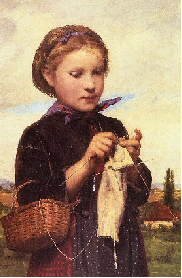How to teach children to Knit!
The following was posted to the knitting list by Margaret K.K. Radcliffe, of Maggie’s Rags, Thanks to her for permission to post it here.
——————————————————————————–
My daughter wanted to learn to knit when she was 3, but I found that she needed help in forming every stitch. She enjoyed knitting with me, but she just didn’t have the dexterity to manage two needles and yarn. When she got bored with it, I didn’t mention it again. When she was just turned 5, she found her knitting bag and brought it to me, asking me to show her how again. We were both pleasantly surprised that she could handle it on her own.
The Waldorf School programs use knitting as a learning tool (great in lots of ways, developing familiarity with natural fibers, dexterity, math skills, design skills, spacial recognition, etc.). One of the basic rules for a beginning knitter is to use natural fibers, and the easiest to work with is wool, so start with wool.
Then, instead of introducing a tool like a knitting noddy, needles, or crochet hook, teach “finger knitting” to begin with. This is just crocheting a chain, but with your fingers. When there is no tool to be dropped and picked up, the child can just get used to the feel of the yarn, and can make a satisfyingly long chain very quickly. These chains can be pulled out and done again, used to join a pair of mittens, chained again to make hair ribbons or belts, used on dolls, as bridles on toy horses, to tie up a younger sibling…you get the idea.
After finger knitting is mastered, move to a knitting noddy or a crochet hook. I found that a big problem when starting off was dropping one of the two needles all the time. When your child wants to move to two needles, then cast on for her, and knit the first row for her. The Waldorf School uses a rhyme to help children remember what to do:
In through the front door
Around the back
Out through the window
And off jumps jack.
Also, don’t fuss over mistakes. If yarnovers result in extra stitches, just make up a little story (about how little birdies flew in and sat on the branch, but now it’s time for them to fly away), and make any corrections necessary to make the piece knittable again. Dropped stitches can be birdies who fell out of the nest, and you can be the mommy bird picking them up. I know this sounds like drivel, but little ones love it. The rhyme and the suggestion for storytelling come from an article in Cast On.
To help ensure success, start will a good quality worsted weight wool yarn, to make it easy. Use wooden needles, because they won’t slip out as easily. And use fairly large needles (like a size 10). Children can make their own needles. Buy some beads at a craft store, and some dowel that fits into the hole. Cut the dowels to length, sharpen in a pencil sharpener, and sand them to make them smooth and round off the points. Glue on the beads at the other end. We made some size 13 wooden needles, but they were really too big. The second set was size 10 and worked much better for a child.
Start with knitting garter stitch swatches, but you can make it interesting by using different colors to make stripes. Let the child decide when the color should change. At our house, these swatches were doll house rugs, placemats for tea sets, or blankets for tiny horses and dolls. Your child’s imagination will decide what they really are.
On the other hand, you could follow the example of EZ’s mother. She let EZ knit 2 or 3 stitches on her own knitting, and then told her she could knit a few stitches the next day if she was good.
Just keep in mind that children learn by imitation, and what your daughter may really want to do right now is to pretend that she can knit like mommy. My two year old is perfectly happy with a large crochet hook, a yard of yarn, and a swatch to pretend with.
Margaret K.K. Radcliffe,
Maggie’s Rags
